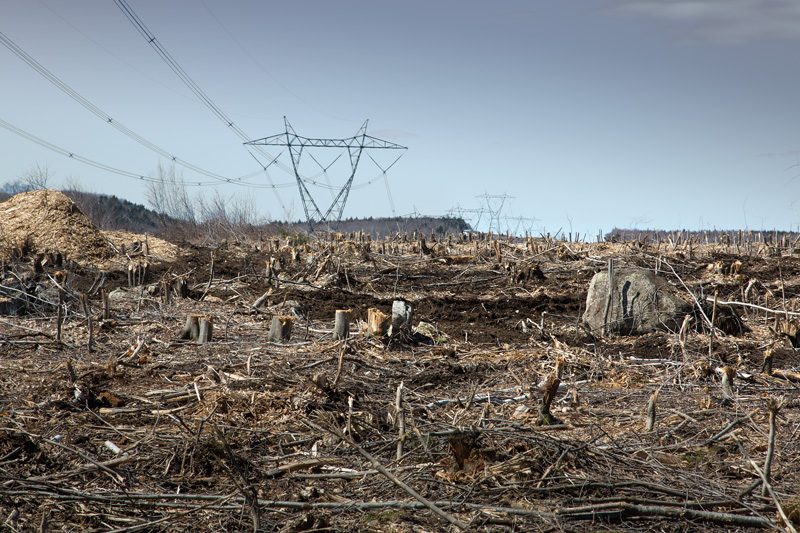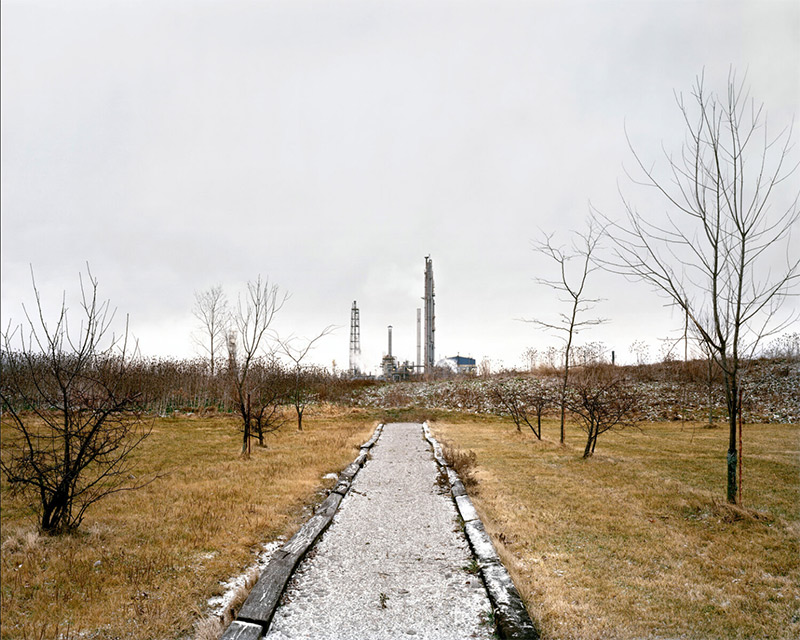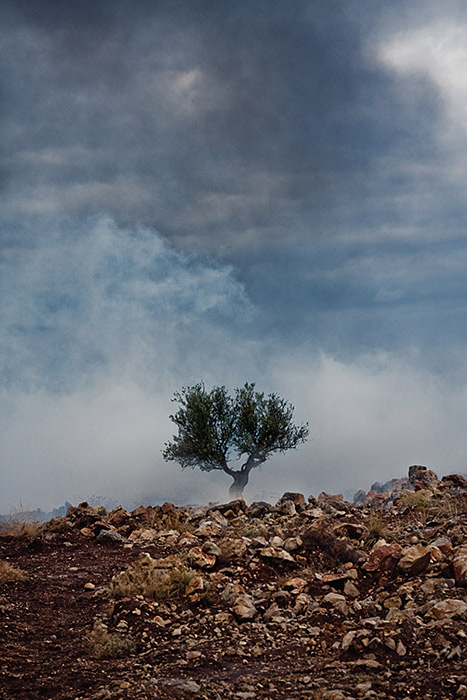Maison de la culture Claude-Léveillée, Montreal
May 30–August 26, 2018
By James D. Campbell
“The world has become self-referring. You know this. This thing has seeped into the texture of the world. The world for thousands of years was our escape, was our refuge. Men hid from themselves in the world. We hid from God or death. The world was where we lived, the self was where we went mad and died. But now the world has made a self of its own.”
— Don DeLillo, The Names
This compelling exhibition of the works of Isabelle Hayeur, Thomas Kneubühler, Jean-François Lemire, Valerian Mazataud, and Andreas Rutkauskas was notable for the trenchant criticality of its thematic engagement with sundry social and environmental issues. Incisively curated by Jean de Julio-Paquin, these several optics dilated on sites in supreme peril at the hands of governmental intervention and systemic upheaval. Where jeopardy and mayhem are visually dramatized, as in the work of Lemire and Mazataud, the result is harrowing and electric. Where their consequences are depicted, as in the work of Hayeur, Kneubuhler, and Rutkauskas, they are always strongly implied and pungently assessed. A documentary aesthetic unites all the works and calls into question the motives and machinations of those staging an ongoing assault on natural and social environments.
Isabelle Hayeur’s resonant images occupy a full wall here. They powerfully demonstrate her extensive strengths and deftly summarize her expansive set of concerns. The artist, a contrarian nomad who has garnered acclaim for her large-scale photographs, experimental videos, site-specific installations, and public art commissions, demonstrates the efficacy of a critique performed through peerless images that explore, relentlessly and with considerable acumen and seductive grandeur, the impact of technology on the lived environment and the impact on our social lives in the wake of that upheaval. For instance, she has been astutely surveying the consequences of Hydro-Québec’s impact on the landscape and local communities. She documents the relatable struggles of citizens in places such as the Lac-Saint-Jean, Mauricie, and Lanaudière regions and those in Saint-Adolphe-d’Howard who view with chagrin the unrelenting invasion of electric pylons on their land.
Hayeur’s implicit critique of global industrial development that generates exponential profits but effaces landscapes grew organically out of her earlier digitally recombinant photos. She has now embraced an equally nuanced documentary approach in which she is apparently more activist than aesthetician. But that is only apparent. Her activism would not be as effective were it not underscored by a remarkably nuanced poetic sensibility. Her work is, at its best, a stunning indictment of institutional abuse of the lived world, in which the perps are named and the damages assessed. But her reading of the landscape itself is at once sensitive and subversive.
The gifted documentarian and narrative storyteller Jean-François Lemire is also an activist. He grapples with his subjects at close quarters, unsparingly but with genuine empathy, as in Migrants (Roxham Road) (2017), in which a mother is captured with eyes downcast, holding a child in one arm, two others in tow, and a bag holding her possessions in the other. It is magnetic because it is so incontrovertibly true. The intimacy established between the photographer’s lens and the subject is something that cannot be feigned, and it is but one authenticating marker among many in this body of work. Indeed, gritty realism and the mindset of an empath are irrevocably wed here, and the dignity of his subjects is thus immeasurably heightened and never demeaned. Lemire parses the luminous moments of a specifically human truth with candour, unassuming grace, and a remarkable absence of guile.
Thomas Kneubühler’s scientific sensibility and attention to secret places – whether it be the Raglan mine in Kattiniq, in the Nunavik region, accessible only by airplanes owned by the mining company, or garden-variety government installations – is served well by the brilliant clarity of his photographic work, which lays bare the architecture of control and concealment. His work has an implicit political dimension. He examines geopolitical tensions and socio-political schisms alike unflinchingly and with rare gravitas. In Land Claim (2014), he provided a knowledgeable portrayal of mining activities in northern Quebec. His images of the Inuit village of Aupaluk, also in Nunavik and under siege by the development of a new iron-mining project, are daringly nuanced and detailed: he reveals power relations ceaselessly at work well under the surface of things with all the archaeological élan of Michel Foucault. Kneubühler’s earlier investigation at Canadian Forces Station Alert in Nunavut, Days in Night (2013 – 14), shines an unsparing light on the heart of darkness itself.
Valerian Mazataud is a freelance documentary photographer with a marked interest in issues pertaining to immigration and natural resources. Having covered at close quarters some of the most important world events and cataclysms of recent years, including the Haiti earthquake, the Arab spring, the drought in East Africa, and the Syrian refugee crisis, Mazataud is entirely unafraid. In 2014, his documentary project We are no more, about Syrian refugees’ memory and loss, was exhibited in the Maison de la culture Mont-Royal in Montreal, as well as in Toronto and France. Mazataud has said, “At the beginning of my project, there is a simple question . . . What would you take if your house had just been bombed or looted by soldiers? What would you take if you had to flee through the night and walk for days to a refugee camp? From us there is no one left to translate the memory and the loss of Syrian refugees in the North of Jordan. In We are no more, I want to translate Syrian refugees in North Jordan.” His Zaatari, Jordanie, le 29 septembre 2012 is remarkable for the candid portrayal of its solitary subject, a young boy wearing a suit in a landscape in which the dusk-tinted smoky blue of the sky lends an eerie halo to a portrait of stunning radiance. In all of these works, specific mention should be made of the artist’s signature palette, governed by a spectrum of frequently hallucinatory blues and laden with affect.
Andreas Rutkauskas seizes on landscapes that have been affected by technology and examines them with bold clarity and a certain athletic agility. In Park and nitrogen fertilizer plant from his series Petrolia, we have a desolate glimpse of what seems a post-apocalyptic environment straight out of Cormac McCarthy’s The Road: the grey road that leads to the plant, flanked by leafless trees and dead grasses, looks forlorn and abandoned. The mute sky lends the scene a sense of utter hopelessness and anomie. Here, the altered landscape of the Real is mensurably inflected by co-intensive psychic perturbations in the interior landscape. Petrolia is particularly interesting in that it reflects the artist’s stratified thinking; at the same time as he elucidates the decommissioning or scaling back of petrochemical processing in Chemical Valley, he offers sundry pastoral landscape views and images of cottage-industry petroleum concerns. Other large-scale photographs expand on what Rutkauskas calls “a dense social landscape” from the periphery of Chemical Valley in which First Nations ceremonial sites, abandoned industry, and environmental-responsibility initiatives all meaningfully collide.
All of these artists share a sheer fearlessness in their dogged pursuit of truth and clarity in a world that offers now no possibility of escape or refuge, and the result is a splendid pantheon of mostly riveting and uncompromising images.
James D. Campbell is a writer and curator who writes frequently on photography and painting from his base in Montreal.
[ Complete issue, in print and digital version, available here: Ciel variable 111 – THE SPACE OF COLOUR ]
[ Individual article in digital version available here: Regards critiques et nouvelle photographie — James D. Campbell ]





